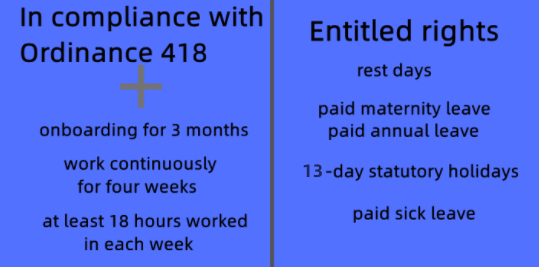Provisions under the Employment (Amendment) Ordinance 2007 (“the E(A)O 2007”) became effective on 13th July, 2007, which is related to the employees’ statutory entitlements. We also name it Ordinance 713 for short. From the commencement date, the employees’ statutory entitlements shall be calculated on the basis of ADW (average daily wage earned in the preceding 12 months) , and the “wages” defined in Employment Ordinance should be included in ADW calculation.
Wages Calculation: Not As Easy As You Think!
If you’re calculating an employee‘s paid leave by basic salary or simply deducting one-day wages, it’s a big mistake!
Upon commencement of the E(A)O 2007, regardless of whether an employee is monthly, daily or piece rate, his relevant statutory entitlements shall be calculated on the basis of his 12-month average wages; and in computing his average wages, any periods and wages that fall under the “disregarding provisions” shall be excluded.
Employees employed on continuous contracts: How to calculate their statutory holiday pay and annual leave pay?

*It is reported that the Labour Department is reviewing Ordinance 418 under the “Employment Ordinance” in 2023, initially put forward 4 plans, and consult the opinions of both employers and employees. According to these plans, the authorities propose to use 4 weeks to calculate the total working hours and require employees to work a total of 72, 68, 64, and 60 hours in 4 weeks in order to enjoy more statutory entitlements.
Statutory holiday pay
Calculation method: Average Daily Wage: Employment Ordinance requires that the following periods and wages are not counted:
(i) The employee taking any of the leave below:
- leave provided under the Employment Ordinance (i.e. rest day, statutory holiday, annual leave, maternity leave, paternity leave or sickness day);
- sick leave due to work injuries as provided under the Employees’ Compensation Ordinance; or
- leave taken with the agreement of the employer;
(ii) The employee not being provided by the employer with work on any normal working day.
*Statutory holidays (labour leave)
| New Year’s Day |
| First three days of Lunar New Year |
| Ching Ming Festival |
| Labour Day(May 1st.) |
| Buddha’s Birthday |
| Tuen Ng Festival |
| July 1st. (Hong Kong Special Administrative Region Establishment Day) |
| The second day following the Chinese Mid-Autumn Festival |
| Chung Yeung Festival |
| October 1st. (National Day) |
| Chinese Winter Solstice Festival or Christmas Day(at the option of the employer) |
【Periods and Wages to be Disregarded:When an employee is not paid his wages or full wages and then exclude the periods together with the wages paid to the employee for such periods】
How to calculate average monthly wage?
Average monthly salary: average daily wage x average number of working days per month
| Average daily wages = | total wages/total number of working days |
| Average working days per month = | working days per week x (365 days – statutory holidays) / 12 months |
*Average working days per month: Generally speaking, the number of working days per month will be affected by factors such as weekends, statutory holidays, and special arrangements of the company, so it is necessary to estimate the actual number of working days per month. In general, the average number of working days per month is approximately 5 days per week, but actual conditions may vary.
However, when calculating the average monthly salary, it is necessary to first calculate the average daily salary and the average number of working days per month.
Example 1: A is a manager of a foreign company, with an annual wage of HK$260,000.00.
Then the average daily wage of A is: HK$ 260,000.00 / 251 (days) = HK$1,035.85
Assuming that A has 5 working days per week and 15 statutory holidays, the average monthly working days is: 5 days x (365 days – 15 days) / 12 months = 20.83 days
Therefore, the average wage of A for 1 month is: HK$1,035.85 x20.83 = HK$21,576.76
Annual leave pay
How to calculate 7-day annual leave pay?
Example 2: C is an operation executive of a listed company, with a monthly wage of HK$18,000, and with payment on rest days.
- Wages earned during the 12 months before the first day of annual leave: HK$18,000*12=HK$216,000, including wages earned from work and holiday payments;
- Leave taken during the 12 months: 71-day full paid leave, including 52 rest days; 13 statutory holidays; 7-day annual leave.
Periods and Wages to be Disregarded
Since the employee has not been paid less than full wages for taking leave during the 12 months, the deducted period and payment are both 「0」.
Annual leave pay based on Average Daily Wage (ADW)
- Calculate the average daily wage earned during the 12 months: HK$216,000-0)/(365 day – 0)= HK$591.78
- 7-day annual leave pay: HK$591.78 x 7 = HK$4,142.46
How to calculate 418 employees’ wages when the employment contract is terminated?

According to Ordinance 「713」, when an employer or an employee terminates the employment contract, they should offer notice period or payment in lieu of notice to each other. The required notice period or payment in lieu of notice is as follows:
| Notice period in days or weeks | Average daily wage earned by the employee in 12 months preceding the day when a notice of termination of contract is given* | X | Number of days in the notice period for which wages would normally be payable to the employee | = | Payment in lieu of notice |
| Notice period in months | Average monthly wage earned by the employee preceding the day when a notice of termination of contract is given** | X | Number of months specified in the notice period | = | Payment in lieu of notice |
*If an employer or employee doesn’t give notice of termination of contract in advance, it will be calculated by the average daily wage earned by the employee in 12 months before the date of contract termination.
**If an employer or employee doesn’t give notice of termination of contract in advance, it will be calculated by the average daily wage earned by the employee in 12 months before the date of contract termination.
Calculate one-month of payment in lieu of notice
Example 3: Assuming that the basic salary of D is HK$15,000 per month, the commission will be accumulated and settled monthly according to the incremental rate.
- Wage earned by the employee in 12 months before the notice date of contract termination: HK$180,000, including basic salary and commission
- Leave taken during the 12-month period and paid less than full salary: Half salary (i.e. 50% of the basic salary), study leave for 15 days, paid HK$3,750
- Commission and payment to be Disregarded: Half paid 15-day study leave and HK$3,750
One month payment in lieu of notice calculated on the basis of 12-month average wages
Calculate the average monthly wage earned during the 12 months:
- Counted months: (365 – 15 day) / 365 day x 12 = 11.5 month
- Average monthly wage: (HK$180,000 – HK$3,750) /11.5 month =HK$15,326.08
Payment in lieu of notice per month: HK$15,326.08
What HR and accountants should pay attention to is when calculating the average wage, the 12-month average wage not only includes basic salary, but also the commission, bonus,etc.(the system of each company is different) during the 12 months.
If you’re looking for a professional HRM system, then Workstem, a cloud-based One-Stop HRM and Payroll System can not only help you professionalise attendance and leave management, but also calculate ADW from payroll and attendance records quickly, efficiently and accurately. And we support Autopay and Xero. All functions on one platform!
Read More:
【Labour Legislation】418, 713 and ADW Calculation
Many Part-time Employees? How to Take Care of the “418” Rule?
Ordinance 418|Do Part-time Employees Have Paid Leave







